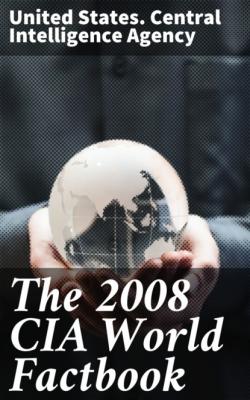The 2008 CIA World Factbook. United States. Central Intelligence Agency
Читать онлайн.| Название | The 2008 CIA World Factbook |
|---|---|
| Автор произведения | United States. Central Intelligence Agency |
| Жанр | Социология |
| Серия | |
| Издательство | Социология |
| Год выпуска | 0 |
| isbn | 4057664638922 |
Exports - commodities:
fish and fish products 94%, stamps, ships (1999)
Exports - partners:
Denmark 29.6%, UK 24.5%, Norway 13.3%, Nigeria 10.5%, Netherlands 6.8% (2007)
Imports:
$751 million c.i.f. (2006)
Imports - commodities:
consumer goods 36%, raw materials and semi-manufactures 32%, machinery and transport equipment 29%, fuels, fish, salt (1999)
Imports - partners:
Denmark 51.9%, Norway 21.6%, Sweden 5%, UK 4.6% (2007)
Economic aid - recipient:
$105 million; note - annual subsidy from Denmark (2005)
Debt - external:
$64 million (1999)
Currency (code):
Danish krone (DKK)
Currency code:
DKK
Exchange rates:
Danish kroner (DKK) per US dollar - 5.4797 (2007), 5.9468 (2006), 5.9969 (2005), 5.9911 (2004), 6.5877 (2003)
Communications
Faroe Islands
Telephones - main lines in use:
23,000 (2006)
Telephones - mobile cellular:
50,000 (2006)
Telephone system:
general assessment: good international communications; good domestic facilities domestic: digitalization was completed in 1998; both NMT (analog) and GSM (digital) mobile telephone systems are installed international: country code - 298; satellite earth stations - 1 Orion; 1 fiber-optic submarine cable to the Shetland Islands, linking the Faroe Islands with Denmark and Iceland; fiber-optic submarine cable connection to Canada-Europe cable
Radio broadcast stations:
AM 1, FM 13, shortwave 0 (1998)
Radios:
26,000 (1997)
Television broadcast stations:
3 (plus 43 repeaters) (September 1995)
Televisions:
15,000 (1997)
Internet country code:
.fo
Internet hosts:
8,516 (2008)
Internet Service Providers (ISPs):
2 (2000)
Internet users:
34,000 (2006)
Transportation
Faroe Islands
Airports:
1 (2007)
Airports - with paved runways:
total: 1 914 to 1,523 m: 1 (2007)
Roadways:
total: 463 km (2006)
Merchant marine:
total: 12 by type: cargo 9, passenger/cargo 3 foreign-owned: 5 (Iceland 1, Norway 4) (2008)
Ports and terminals:
Torshavn, Vagur
Military
Faroe Islands
Military branches:
no regular military forces
Manpower available for military service:
males age 16–49: 11,725 (2008 est.)
Manpower fit for military service:
males age 16–49: 9,735 (2008 est.)
Manpower reaching militarily significant age annually:
male: 400 female: 387 (2008 est.)
Military expenditures:
NA
Military - note:
defense is the responsibility of Denmark
Transnational Issues
Faroe Islands
Disputes - international:
because anticipated offshore hydrocarbon resources have not been realized, earlier Faroese proposals for full independence have been deferred; Iceland, the UK, and Ireland dispute Denmark's claim that the Faroe Islands' continental shelf extends beyond 200 nm
This page was last updated on 18 December, 2008
======================================================================
@Fiji
Introduction
Fiji
Background:
Fiji became independent in 1970, after nearly a century as a British colony. Democratic rule was interrupted by two military coups in 1987, caused by concern over a government perceived as dominated by the Indian community (descendants of contract laborers brought to the islands by the British in the 19th century). The coups and a 1990 constitution that cemented native Melanesian control of Fiji, led to heavy Indian emigration; the population loss resulted in economic difficulties, but ensured that Melanesians became the majority. A new constitution enacted in 1997 was more equitable. Free and peaceful elections in 1999 resulted in a government led by an Indo-Fijian, but a civilian-led coup in May 2000 ushered in a prolonged period of political turmoil. Parliamentary elections held in August 2001 provided Fiji with a democratically elected government led by Prime Minister Laisenia QARASE. Re-elected in May 2006, QARASE was ousted in a December 2006 military coup led by Commodore Voreqe BAINIMARAMA, who initially appointed himself acting president. In January 2007, BAINIMARAMA was appointed interim prime minister.
Geography
Fiji
Location:
Oceania, island group in the South Pacific Ocean, about two-thirds of the way from Hawaii to New Zealand
Geographic coordinates:
18 00 S, 175 00 E
Map references:
Oceania
Area:
total: 18,270 sq km land: 18,270 sq km water: 0 sq km
Area - comparative:
slightly smaller than New Jersey
Land boundaries:
0 km
Coastline:
1,129 km
Maritime claims:
measured from claimed archipelagic straight baselines territorial sea: 12 nm exclusive economic zone: 200 nm continental shelf: 200-m depth or to the depth of exploitation; rectilinear shelf claim added
Climate:
tropical marine; only slight seasonal temperature variation
Terrain:
mostly mountains of volcanic origin
Elevation extremes:
lowest point: Pacific Ocean 0 m highest point: Tomanivi 1,324 m
Natural
